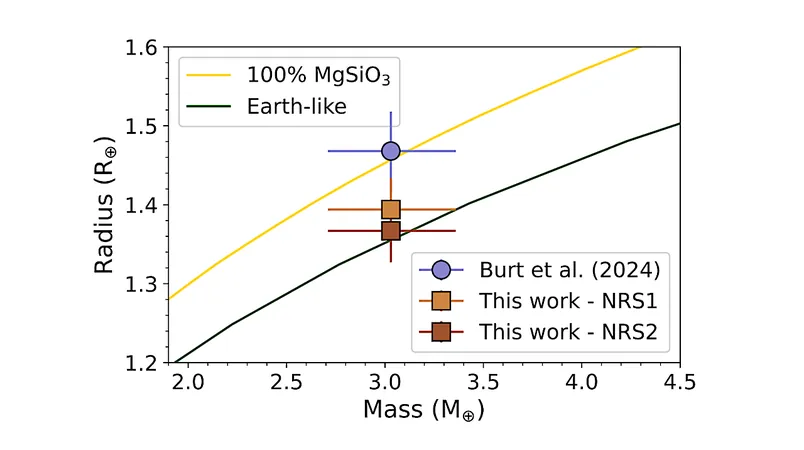
Unveiling the Secrets of TOI-1685 b: The Mystery of a Hot Rocky Exoplanet!
2024-12-05
Author: Rajesh
Astronomers' Observations of TOI-1685 b
Astronomers have turned their gaze towards the intriguing exoplanet TOI-1685 b, a hot rocky super-Earth orbiting a dim M2.5V star, in an effort to understand its atmospheric composition and thermal characteristics through the advanced capabilities of the James Webb Space Telescope (JWST) NIRSpec instrument during a complete orbit.
Recent Findings on Atmospheric Composition
Recent observations have yielded both transmission and emission spectra for TOI-1685 b, allowing scientists to delve into the planet's phase curve properties, including amplitude and offset nuances. Notably, the transmission spectrum has provided strong evidence against the existence of a hydrogen-dominated atmosphere, which may be expected in many exoplanets. Instead, the planet's secondary atmospheres, which could potentially be composed of water, methane, or carbon dioxide, could not be distinctly identified from a flat spectral line, leaving the nature of TOI-1685 b's atmosphere shrouded in mystery.
Emission Spectrum Insights
The emission spectrum of TOI-1685 b is strikingly featureless and aligns closely with a blackbody-like brightness temperature. This observation helps discount the possibility of a thick atmosphere with a high average molecular weight, further enhancing the notion that this planet may lack the type of substantial atmosphere that many had speculated. Current analyses indicate that TOI-1685 b behaves similarly to a blackbody with minimal heat redistribution and a low reflective albedo. The dayside brightness temperature has been measured as 0.98±0.07 times that of a perfect blackbody across the NIRSpec's NRS2 wavelength range (3.823-5.172 micrometers). These findings contribute to the accumulating evidence that highlights the rarity of atmospheres among rocky planets orbiting M stars, refining our understanding of the so-called "Cosmic Shoreline."
Investigating Systematic Noise
Interestingly, the study revealed high-amplitude correlated noise within the data from both the white light and spectroscopic light curves, a finding replicated across three different data reductions. The source of this noise appears to stem from instrumental artifacts rather than astrophysical processes, demonstrated by differing correlated noise properties between NRS1 and NRS2 detectors, which exhibit strongest components on timescales of 4.5 hours and 2.5 hours, respectively. This suggests there's much to learn about the handling of systematic noise within NIRSpec during extensive time-series observations.
Future Exploration Opportunities
In light of these findings, we invite the broader astronomical community to investigate the systematics of NIRSpec further, especially concerning the collection of long-duration observational data. The enigmatic TOI-1685 b holds the potential to reshape our understanding of super-Earths and their atmospheric formations, making it a prime candidate for future exploration. Stay tuned as researchers continue to peel back the layers of mystery surrounding this captivating exoplanet!



 Brasil (PT)
Brasil (PT)
 Canada (EN)
Canada (EN)
 Chile (ES)
Chile (ES)
 España (ES)
España (ES)
 France (FR)
France (FR)
 Hong Kong (EN)
Hong Kong (EN)
 Italia (IT)
Italia (IT)
 日本 (JA)
日本 (JA)
 Magyarország (HU)
Magyarország (HU)
 Norge (NO)
Norge (NO)
 Polska (PL)
Polska (PL)
 Schweiz (DE)
Schweiz (DE)
 Singapore (EN)
Singapore (EN)
 Sverige (SV)
Sverige (SV)
 Suomi (FI)
Suomi (FI)
 Türkiye (TR)
Türkiye (TR)